| Hirtenberg HV.15 | |
|---|---|
 | |
| Role | Passenger aircraft |
| National origin | Austria |
| Manufacturer | Hirtenberg |
| First flight | March 8, 1936 |
| Number built | 1 |
The Hirtenberg HV.15 was a twin-engine Austrian monoplane produced by Hirtenberg.
| Hirtenberg HV.15 | |
|---|---|
 | |
| Role | Passenger aircraft |
| National origin | Austria |
| Manufacturer | Hirtenberg |
| First flight | March 8, 1936 |
| Number built | 1 |
The Hirtenberg HV.15 was a twin-engine Austrian monoplane produced by Hirtenberg.
The HV.15 was the company's first twin-engined aircraft, originally made for the civilian market. Designed for mass production, the aircraft was planned to be a passenger aircraft or light transport. The HV.15 first flew on March 8, 1936, powered by the most powerful engines available to Austria at the time, a pair of Siemens-Halske Sh 14A rotary engine, each producing 160 hp (119 kW).
General characteristics
Performance

The Focke-Wulf Fw 44 Stieglitz ("Goldfinch") is a 1930s German two-seat biplane. An early design by Kurt Tank, it was produced by the Focke-Wulf company as a pilot training and sports flying aircraft. It was also eventually built under license in several other countries.

The Dornier Do 11 was a German heavy bomber, developed in secret in the early 1930s. It was originally called the Dornier F before being renamed by the Reichsluftfahrtministerium (RLM) in 1933, and was considered a heavy bomber at the time. It came into service in 1932, a continuation of a line of bomber designs from the Dornier Do P in 1930, and the Dornier Do Y in 1931. The line would continue to develop with the Dornier Do 13 and Dornier Do 23.
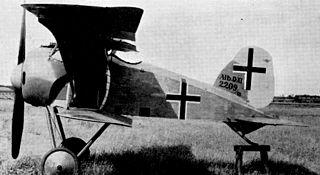
The Albatros D.XI was a German single-seat fighter biplane first flown in February 1918. It was the first Albatros fighter to use a rotary engine, in the form of the 120 kW (160 hp) Siemens-Halske Sh.III, and also featured a new wing construction with diagonal struts from the fuselage replacing traditional wire bracing.

The Heinkel He 72 Kadett ("Cadet") was a German single-engine biplane trainer of the 1930s.
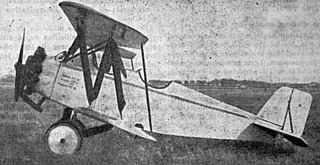
The Albatros L 68 Alauda was a two-seat German trainer aircraft of the 1920s. It was a single-engine biplane of conventional configuration that seated the pilot and instructor in tandem, open cockpits. The wings were of unequal span and had a pronounced stagger.

The Arado S I was a biplane trainer built in Germany in 1925. The first of three prototypes was powered by a Bristol Lucifer radial engine, while the other two Arado S.Ia aircraft were fitted with the Siemens-Halske Sh 12. The Siemens-Halske Sh 11 powered the Arado S III, a virtually identical aircraft of which only a single prototype was constructed and sold to Turkey.
The Arado W 2 was a two-seat twin-engine seaplane trainer developed for the DVS in 1928. It was a cantilever monoplane with a fabric-covered steel tube fuselage that accommodated the pilot and instructor in tandem open cockpits. The undercarriage consisted of two pontoons carried on steel struts.

The Pfalz D.VIII was a German World War I fighter aircraft.

The Dornier Libelle, also designated Do A, was a German open-cockpit, all-metal, parasol wing, monoplane flying boat aircraft, with partly fabric-covered wings. A landplane version, built without sponsons and fitted with a fixed tailwheel undercarriage was produced as the Dornier Spatz.
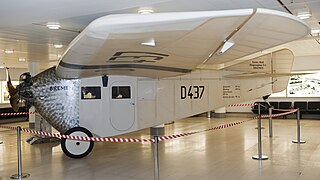
The Focke-Wulf A.16 was a German three/four passenger light transport monoplane designed by Heinrich Focke and Georg Wulf and was the first design built by the newly formed Focke-Wulf company.

The Fokker S.IV was a military trainer aircraft produced in the Netherlands in the mid-1920s. It was a conventional, single-bay biplane with staggered wings of unequal span braced with N-struts, essentially a radial-engined development of the S.III. The pilot and instructor sat in tandem, open cockpits and the undercarriage was of fixed, tailskid type with a cross-axle between the main units. The Royal Netherlands Army Aviation Group purchased 30 examples and used them right up to the German invasion of the Netherlands in 1940. On 14 May that year, a few surviving S.IVs escaped to France alongside some S.IX trainers, but never flew again.

The Klemm Kl 36 is a 1930s German four-seat cabin touring and competition monoplane. It was designed by Klemm and Friedrich Fechner and built by Klemm.

The Hopfner HA-11/33 was an amphibious flying boat built in Austria in 1933 to a specification by the Dr. Oetker company. The result was a conventional, high-wing cantilever monoplane with a stepped flying boat hull and pontoons on struts under the wings at mid-span. The cabin was fully enclosed, and the twin engines were mounted tractor-fashion on struts above the wing.
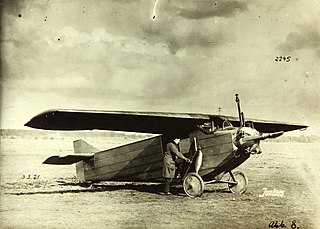
The Junkers K 16 was a small airliner produced in Germany in the early 1920s. It was a conventional, high-wing cantilever monoplane of all-metal construction, equipped with fixed, tailwheel undercarriage. The pilot sat in an open cockpit, while the two passengers were provided with an enclosed cabin within the fuselage. Shortly after the prototype flew, aircraft production in Germany was brought to a complete halt by the Allies, and the K 16 was quickly evacuated to the Netherlands to avoid confiscation. There, it was stored by Fokker until the restrictions were relaxed and work recommenced at Junkers' Dessau factory in 1924. By this time, however, the airline niche that the tiny K 16 had been intended to fill no longer existed, and the small number that were produced were mostly sold to private owners. Junkers entered two K 16s in the 1925 Deutsche Rundflug, with one machine winning second place in the competition.

The Swallow TP was a trainer aircraft produced by the Swallow Airplane Company in the United States from 1928.

The Bayerische Flugzeugwerke M 18, was an airliner, produced in Germany in the late 1920s.

The Nuri Demirağ Nu.D.38 was a Turkish light civil transport, with twin engines and seating for four passengers, built in the early 1940s. Only one was constructed and flown.
The Udet U 11 Kondor was a German four-engined airliner designed and built by Udet Flugzeugbau, only one was built.

The Darmstadt D-29 was a German experimental monoplane designed and built by Akaflieg Darmstadt. The D-29 was a cantilever low-wing monoplane designed and built during 1936 with a conventional landing gear with a tailskid. It was powered by a Siemens-Halske Sh 14a radial piston engine and had enclosed tandem cockpits, as well as a number of other features, including hydraulically actuated trailing-edge flaps, a braced T-tail and leading-edge slots.
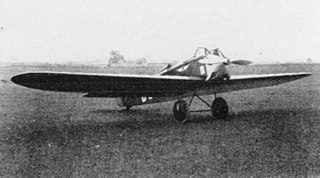
The Udet U 1 was the first of a line of small, low-powered, low wing, cantilever monoplanes built in Germany in the early 1920s.